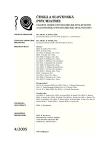Dual-acting Antidepressants
Authors:
E. Češková
Authors‘ workplace:
Psychiatrická klinika LF MU a FN, Brno
přednostka prof. MUDr. E. Češková, CSc.
Published in:
Čes. a slov. Psychiat., 101, 2005, No. 4, pp. 207-212.
Category:
Comprehensive Reports
Overview
At first a history of development of antidepressants is mentioned. Dual-acting antidepressants are a relatively recent class of antidepressants. They include both serotonin and norepinephrine reuptake inhibitors (SNRI), e.g. venlafaxine, milnaciprane and duloxetine and a representative of noradrenergic and specific serotonergic antidepressants (NaSSA) mirtazapine. Further individual dualacting antidepressants are compared including pharmacological profile, pharmacokinetics, efficacy and side effects. In some studies their profile of effectiveness was comparable to tricyclics and higher than SSRIs. They are better tolerated than tricyclics and similar to SSRIs. They have also a higher rate of remissions and according to some studies it seems that they have a faster onset of efficacy. Finally new indications of dual-acting antidepressant are cited, e.g. anxiety disorders and pain including depression associated pain.
Key words:
dual-acting antidepressants, venlafaxine, milnaciprane, duloxetine, mirtazapine, efficacy, tolerability, indication.
Labels
Addictology Paediatric psychiatry PsychiatryArticle was published in
Czech and Slovak Psychiatry

2005 Issue 4
Most read in this issue
- Dual-acting Antidepressants
- On Intuition and Intuitive Diagnostics in Psychiatry
- DNA Polymorphism of Monoamine Oxidase B Gene Influences Pain Feeling
- Possibilities and Limits of Therapy in Patients with Disorders of Food Intake Executed in a Form of Daily Stationary in the Czech Republic and Abroad
